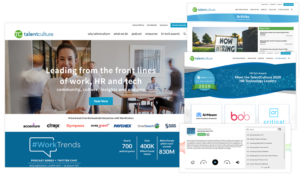
TalentCulture’s New Look: Announcing Our New Website!
We’re thrilled to announce that our newly revamped website is now live! In keeping with our mission, it offers the insights that empower HR, the

We’re thrilled to announce that our newly revamped website is now live! In keeping with our mission, it offers the insights that empower HR, the

Marketing and HR have started to collaborate with great success. Here’s why it might be time to bring a marketer on to the HR team full time.

Digital marketing is on the rise in recent years, so it makes sense that marketing professionals will be increasingly in demand in the near future.

Astronaut. Teacher. Ballerina. Doctor. Singer. Few people say “I want to grow up and work in an office,” yet 15 percent of Americans have office/administrative
The topic of entrepreneurship fascinates me. I often wonder what makes one person seek out entrepreneurial opportunities while others are content to be employees. I
In this Corner Office article, Cyndy Trivella, Events Manager with TalentCulture, spoke with Brian Carter, Founder and CEO of The Carter Group and Co-author of
As we dive into the new year, top of mind for a lot of us are questions of need and want. One of which is the
Many companies devalue marketing, considering it the department that makes pretty pictures or the administrative support for the sales team. Others strongly value the strategic
Maybe you’ve fantasized about quitting, but you’re not ready to give up your steady paycheck, 401k, or insurance. There is a quick alternative. Transform your
While recruitment and marketing may traditionally have been thought of as separate entities, they can actually work hand in glove. Recruitment marketing uses elements of
Social is the great ice breaker. It allows people to get introduced, forge relationships and to share experiences and information, of all types, with ease

Today’s global marketplace is fiercely competitive. But smart companies recognize their primary business advantage comes from within

The social era is creating a whole new level of opportunity for business and personal brands. Are you making the most of it?

Are you selling products to a market? Or are you investing in relationships that will lift your brand? Community counts.

What does it really mean to be a social influencer? And what does that imply for business and HR leaders? #TChat speaks

Social media is redefining influence in all respects. What does this mean for employer and personal brands? Let’s talk about it…

Companies can no longer afford to think and act like recruiting and marketing are world’s apart. It’s time for a collaborative approach…

Every company has a distinctive organizational culture and “hiring culture.” To improve the impact of your hiring culture, focus on 3 essential elements…
“Any change, even a change for the better, is always accompanied by drawbacks and discomforts.” — Arnold Bennett Not really what we want to hear
As an organization, your perceived workplace culture is a part of your brand. So, what can you do to market your workplace culture better to your employees? It’s a question we shouldn’t ignore…
I, like most of my fellow bloggers out there, do not have the funds necessary to launch national advertising campaigns to promote a blog. Therefore, since my team and I founded Career Rocketeer over a year ago, I have constantly faced the challenge of finding new, free and/or low-cost ways to promote our content, build up our blog’s awareness and increase our readership. Thankfully, if you are creative and determined, you can uncover countless ways to promote your efforts without breaking the bank.